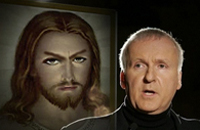Scientist says 'Jesus Tomb' documentary based on mistake
A prominent scholar looking into the factual basis of a popular but widely criticized documentary film that claims to have located the tomb of Jesus said Tuesday that a crucial piece of evidence filmmakers used to support their claim is a mistake.

Stephen Pfann, a textual scholar and paleographer at the University of the Holy Land in Jerusalem, said he has released a paper claiming the makers of "The Lost Tomb of Jesus" were mistaken when they identified an ancient ossuary from the cave as belonging to the New Testament's Mary Magdalene.
Produced by Oscar-winning director James Cameron and directed by Simcha Jacobovici, the documentary has drawn intense media coverage for its claims challenging accepted Christian dogma.
Despite widespread ridicule from scholars, it drew more than 4 million viewers when it aired on the Discovery Channel on March 4. A companion book, "The Jesus Family Tomb," has rocketed to sixth place on the New York Times nonfiction best-seller list.
The film and book suggest that a first-century ossuary found in a south Jerusalem cave in 1980 contained the remains of Jesus, contradicting the Christian belief that he was resurrected and ascended to heaven. Ossuaries are stone boxes used at the time to store the bones of the dead.
The filmmakers also suggest that Mary Magdalene was buried in the tomb, that she and Jesus were married, and that an ossuary labeled "Judah son of Jesus" belonged to their son.
The scholars who analyzed the Greek inscription on one of the ossuaries after its discovery read it as "Mariamene e Mara," meaning "Mary the teacher" or "Mary the master."
Before the movie was screened, Jacobovici said that particular inscription provided crucial support for his claim. The name Mariamene is rare, and in some early Christian texts it is believed to refer to Mary Magdalene.
But having analyzed the inscription, Pfann, who made a brief appearance in the film as an ossuary expert, published a detailed article on his university's Web site asserting that it doesn't read "Mariamene" at all.
The inscription, Pfann said, is made up of two names inscribed by two different hands: the first, "Mariame," was inscribed in a formal Greek script, and later, when the bones of another woman were added to the box, another scribe using a different cursive script added the words "kai Mara," meaning "and Mara." Mara is a different form of the name Martha.
According to Pfann's reading, the ossuary did not house the bones of "Mary the teacher," but rather of two women, "Mary and Martha."
"In view of the above, there is no longer any reason to be tempted to link this ossuary...to Mary Magdalene or any other person in Biblical, non-Biblical or church tradition," Pfann wrote.
In the interest of telling a good story, Pfann said, the documentary engaged in some "fudging" of the facts.
"James Cameron is a great guru of science fiction, and he's taking it to a new level with Simcha Jacobovici. You take a little bit of science, spin a good yarn out of it and you get another Terminator or Life of Brian," Pfann said.
In Israel Tuesday for a screening of the film, the Toronto-based Jacobovici welcomed Pfann's criticism, saying "every inscription should be re-examined."
But Jacobovici said scholars who researched the ossuary in the past agreed with the film's reading. "Anyone who looks at it can see that the script was written by the same hand," Jacobovici said.
Jacobovici has faced criticism much tougher than Pfann's academic critique. The film has been termed "archeo-porn," and Jacobovici has been accused of "pimping the Bible", reports AP.
Jacobovici attributes most of the criticism to scholars' discomfort with journalists "casting light into their ossuary monopoly."
"What we're doing is democratizing this knowledge, and this is driving some people crazy," Jacobovici said.
Subscribe to Pravda.Ru Telegram channel, Facebook, RSS!


